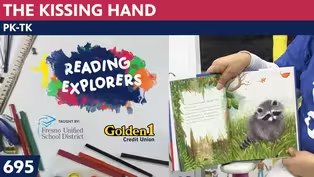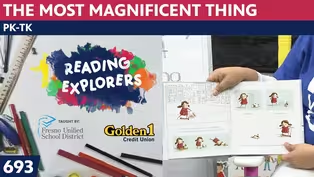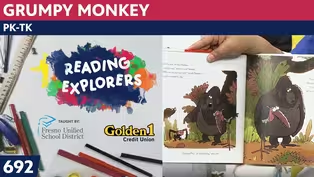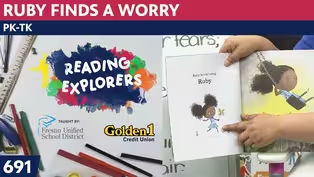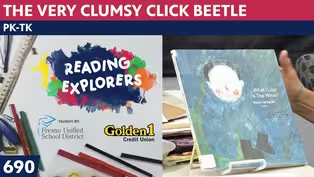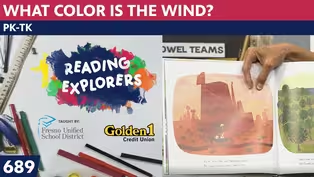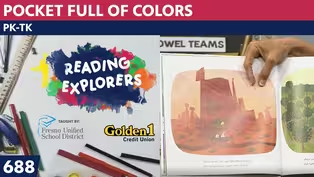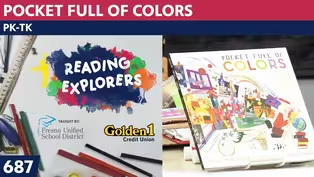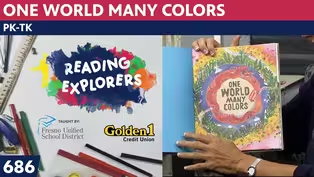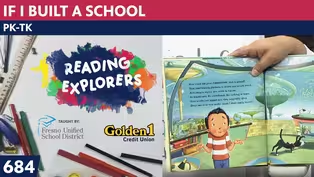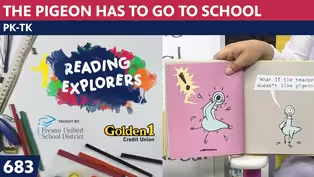
TK-350: Gustav Klimt
Season 3 Episode 276 | 14m 14sVideo has Closed Captions
Join Mrs. Readwright at Camp Discovery!
Transitional Kindergarten teacher, Mrs. Readwright, welcomes students back to Camp Discovery, a fun learning space packed with reading adventures & fun games!
Problems playing video? | Closed Captioning Feedback
Problems playing video? | Closed Captioning Feedback
Reading Explorers is a local public television program presented by Valley PBS

TK-350: Gustav Klimt
Season 3 Episode 276 | 14m 14sVideo has Closed Captions
Transitional Kindergarten teacher, Mrs. Readwright, welcomes students back to Camp Discovery, a fun learning space packed with reading adventures & fun games!
Problems playing video? | Closed Captioning Feedback
How to Watch Reading Explorers
Reading Explorers is available to stream on pbs.org and the free PBS App, available on iPhone, Apple TV, Android TV, Android smartphones, Amazon Fire TV, Amazon Fire Tablet, Roku, Samsung Smart TV, and Vizio.
Providing Support for PBS.org
Learn Moreabout PBS online sponsorshipMore from This Collection
Valley PBS and Fresno Unified School District have partnered with Golden 1 Credit Union to create Reading Explorers Lessons for grades Pre-Kindergarten through Third grade. The daily lessons will be taught by Fresno Unified School District teachers and are created to help students practice their reading skills and reinforce lessons during distance learning.
Video has Closed Captions
Valley PBS presents Reading Explorers Lessons for Pre-Kindergarten and TK. (26m 27s)
PK-TK-693-The Most Magnificent Thing
Video has Closed Captions
Valley PBS presents Reading Explorers Lessons for Pre-Kindergarten and TK. (26m 26s)
Video has Closed Captions
Valley PBS presents Reading Explorers Lessons for Pre-Kindergarten and TK. (26m 28s)
Video has Closed Captions
Valley PBS presents Reading Explorers Lessons for Pre-Kindergarten and TK. (26m 28s)
PK-TK-690: The Very Clumsy Click Beetle
Video has Closed Captions
Valley PBS presents Reading Explorers Lessons for Pre-Kindergarten and TK. (26m 22s)
PK-TK-689: What Color is the Wind?
Video has Closed Captions
Valley PBS presents Reading Explorers Lessons for Pre-Kindergarten and TK. (26m 21s)
PK-TK-688: Pocket Full of Colors
Video has Closed Captions
Valley PBS presents Reading Explorers Lessons for Pre-Kindergarten and TK. (25m 58s)
PK-TK-687: Dancing Through Fields of Colors
Video has Closed Captions
Valley PBS presents Reading Explorers Lessons for Pre-Kindergarten and TK. (26m 20s)
PK-TK-686: One World Many Colors
Video has Closed Captions
Valley PBS presents Reading Explorers Lessons for Pre-Kindergarten and TK. (27m 13s)
PK-TK-685: School is Wherever I am
Video has Closed Captions
Valley PBS presents Reading Explorers Lessons for Pre-Kindergarten and TK. (26m 32s)
PK-TK-684: If I Built a School
Video has Closed Captions
Valley PBS presents Reading Explorers Lessons for Pre-Kindergarten and TK. (26m 21s)
PK-TK-683: The Pigeon Has to Go to School
Video has Closed Captions
Valley PBS presents Reading Explorers Lessons for Pre-Kindergarten and TK. (26m 22s)
Providing Support for PBS.org
Learn Moreabout PBS online sponsorship- [Singer] ♪ Good morning to a brand new day ♪ ♪ Time to learn and the games to play ♪ ♪ Learning things is so much fun ♪ ♪ Learning is good for everyone ♪ (vibrant music) - Hello, early learners.
It's named Mrs. Readwright, welcome back to the art room.
It is Friday and we are doing letter T. Let's do our hello song, today it is a goat.
♪ When goats get up in the morning ♪ ♪ They always say, good day ♪ ♪ When goats get up in the morning ♪ ♪ They always say, good day ♪ ♪ Nah, nah, nah ♪ ♪ This is what they say.
♪ ♪ Nah, nah, nah ♪ ♪ This is what they say.
♪ And in the alphabet song we know we're going to be doing something that starts with T. And let's sing it.
♪ A, B, C, D, E of art.
♪ ♪ That's the way that we will start ♪ ♪ P is for puppet.
♪ ♪ Q starts for queen ♪ ♪ R is for roses that we have seen ♪ ♪ S is for sunflower ♪ ♪ Trees start with T ♪ ♪ Art and the alphabet A, B, C ♪ And the artists were meeting today is an old artist from long ago, Gustav Klimt.
Now remember Gustav, he did The Tree of Life with the golden paint.
We made golden nutcracker guys from Gustav Klimt, and we made a Gustav Klimt, the kiss on our sunflower on our, no, it was on our snowman.
And so today he did pictures of birch trees.
I have a birch tree in my front yard and I brought one of the branches when I trimmed and look at it.
It has white bark and it has little pieces of where the branches or the places where it was growing out little twigs.
And that we're going to be doing some marks on ours painting after we take off the yarn.
Yarn with a painting?
I'm going to show you.
I'm doing a sponge print because if we look at this painting by Gustav Klimt, you can see that they're orange leaves all on the floor of the forest.
And this is where it starts getting darker up to the top, is where the sky is and where a lot of the trees are growing.
Let's see what the riddle or rhyme says.
T is for tree.
Klimt painted for us in the early morning light, the slim trunks of birch trees with bark that is white.
So let me set down my white birch branch and tell you about the name of this is called "Birch Forest."
So let's move things aside.
And he tried to make his trees look 3D, which means three dimensional, that it's not flat.
And I wanted to also tell you if you're making your art and you think you can get to a camera and have someone take your picture and send it to me here at the studio, I would love to see it.
It doesn't have to be the tree, it can be any of the art projects that we've done in the past and include your home address.
And that way the studio can send you one of these activity books that I know you will love to get in the mail.
So let me set these aside and I'll pick up my table and show you the process.
Now interesting about this process is it starts out with a piece of cardboard.
And I found a cardboard box that was still white.
It was on the lid and I use the handle of my puppet on Monday was the lid of this box, and I folded it in half.
But this I'm wanting to do it vertically like this because I'm going to start out by wrapping yarn.
Now I'm going to put this yarn and my yarn is kind of cottony.
And if you have string, it will work but not as good because it has to be kind of wide, 'cause we're going to sponge paint over and not too much paint because as we paint this, we want the yarn to keep the paint from going on to the paper.
So I'm taping it on the back and then I begin to wrap.
Now the trees don't all stand up perfectly straight.
So I'm going to wrap this and put some straight up and some bent over a little bit.
And I'll put, I don't know, maybe five to eight of them.
Let me count how many I've gone around down.
One, two, three, four, five, six, maybe I'll do one more.
I'll put one really close to this one.
And when I get to the back, I use my scissors, and cut it off, and I will tape it to the back too.
The beginning gets taped and the ending gets taped, and I'm going to do it long wise because that has more area that would have to pull out of, because I'm don't want to press too much paint into the yarn, 'cause we want it to block the paint from getting on the white.
Now I have two containers because I'm going to do some of it the leaves.
And you know wherever the yarn is, is going to stay white.
These are pretty skinny trees, I probably should have put two side by side but I think it will be okay.
And you know, I just got an old sponge.
If you have cotton balls, you could use cotton balls to tap, tap, tap, tap, tap on here.
I'm going to do the bottom half, the orange, and the top half is going to be green.
And so I'm going to start with my orange and yellow orange kind of on here.
So I'm going to go and just tap, tap, tap.
I'm not rubbing it, I'm tap, tap, tapping it.
So I tap, tap, tap, and tap, tap, tap.
'Cause if I rub it, it will move the yarn side to side and it won't make it be next to the yarn that's supposed to block the paint and show the trees.
So you can see I'm using a little yellow and some other colors down here 'cause not all of those leaves are orange.
You can see in the background there's some brownish ones and there's some greenish ones.
And remember, I'm just up and down and up and down tapping.
I don't want to brush it like a paintbrush and I wanna get all the way across.
So over here, I don't have to be as careful because there's no yarn there.
I'm gonna turn it this way so I can do it away from me a little bit, and I'm gonna get a little bit of that yellow and green on it too.
Up and down, still getting the up and down motion.
Well, that time I got too much paint on and tried to lift up the yarn when I was doing it, I have to be more careful.
I get too busy going crazy and talking at the same time.
Now a little bit of green, starting up to the green part.
And I think I will use a different one that doesn't have as much orange on it.
And I'll go in here and get some of the olive green and brown and put it into the tree canopy so that you can see that it's gonna have all different colors of green.
And I do like that one, I mixed some green with brown so it makes it kind of olive green, kind of like the one that Klimt has in his picture.
I put a little black and some of it too.
And when I do this, I brought a black pen so that when I want to show those branches... Lemme move these big guys out of the way I don't think I'll be using them.
When I want to show those branches and how much that they have blocked the paint, I can draw little black lines on there.
You notice that I'm getting close to my yarn because otherwise the white will show and you'll say, "Well where's the tree part," because I didn't get right next to the yarn.
And I'm being careful in doing that now.
And I would probably do even more careful painting, but I want to be sure to show you how to make the black lines once we take off the yarn.
And I wanna get a little more of this olive green kind.
If you don't have sponge you use cotton ball.
I also brought a few of those cotton swabs because when I'm finished I might want to add a little yellow down with these leaves, or a little color that I haven't used, but let's see if it blocked the paint.
Let me take off my tape in the back.
You know what I'm doing?
I'm pulling the tape.
Oh, you know what?
I could even just cut it off.
Well, look it did it boys and girls.
It left the white tree branches and the trunks, just what I wanted.
I had tried it at home with some really thick yarn but I knew that nobody at home would ever have that really thick yarn like they let you use at school.
So I thought just use what kids will have 'cause you can get this yarn at that store that only costs a dollar for things.
And I thought that's fair to show them that one.
Now look, there trees are, and I can now use my skinny black pen to make the places that I was telling you about that look like where the little branch come out.
So you just do little lines across like the birch tree has.
And if you got to see my branch I brought today, you could see that little black lines are all the way down the trunk.
I'm just doing little short, tiny little straight lines all across my trees like this.
Oh, I'm liking this very much boys and girls.
I can see where I accidentally bent my cardboard right here, no paint went, but I can get through on that with a sponge and just paint a little bit.
I'm still doing my black lines, there's no need to rush.
I could even leave some to do them later, and I think I will.
'Cause I wanna show you about these cotton swabs.
I want to add a little bit of brown and olive green down here with some of the leaves where they didn't get painted.
I could get in there with a little bit more orange next to, but not where the tree is.
Now I'm filling in the places where I think needs a little more color.
And if I want to add a little yellow I could, maybe up in these, some of these branches along here, and I can go up here and maybe some of the sunlight's coming through and I'm just tap, tap, tapping with all my colors that I'd like to try.
And I really do like when the color is the brown and the green together, that olive green color.
And I can go across here in this little place where it was kind of in that place where, that's a little better.
In that place where the cardboard was bent.
I'll go in there a bit, it makes it a little easier to see.
Okay.
Boys and girls this has been a great week, you know what next week is.
I wanted to teach you how to paint paper 'cause a bunch of our projects could use some painted paper kind of how Eric Carle does in his books.
So if you will collect any kind of tools that you want to paint paper and scrape like with a comb or print with a fork or something, do that and we can paint some paper.
But here is my birch forest.
All right, boys and girls.
Let's sing goodbye to one another and kind of talk about how you're doing with your art.
So here we go.
♪ Oh, it's time to say goodbye to all my friends ♪ ♪ Oh, it's time to say goodbye to all my friends ♪ ♪ Oh, it's time to say goodbye ♪ ♪ Give a smile and wink your eye ♪ ♪ Oh, it's time to say goodbye to all my friends ♪ I just forgot I was gonna tell you about this.
I wanna make sure that I put a border around that 'cause on all of the art that I've been showing you I've been putting frames around it.
Well, it's been a great week.
The ABCs of art are wrapping up for today but we'll pick them back up on Monday, and I think I might have a mystery for the suitcase that day because I found something really exciting to use for the letter U.
So I will see you next week.
Thank you for joining me.
Bye boys and girls.
Have a great weekend.
(bright music) - [Singer] ♪ Good morning to a brand new day ♪ ♪ Time to learn and games to play ♪ ♪ Learning things is so much fun ♪ ♪ Learning is good for everyone ♪ (bright guitar music)
Support for PBS provided by:
Reading Explorers is a local public television program presented by Valley PBS
